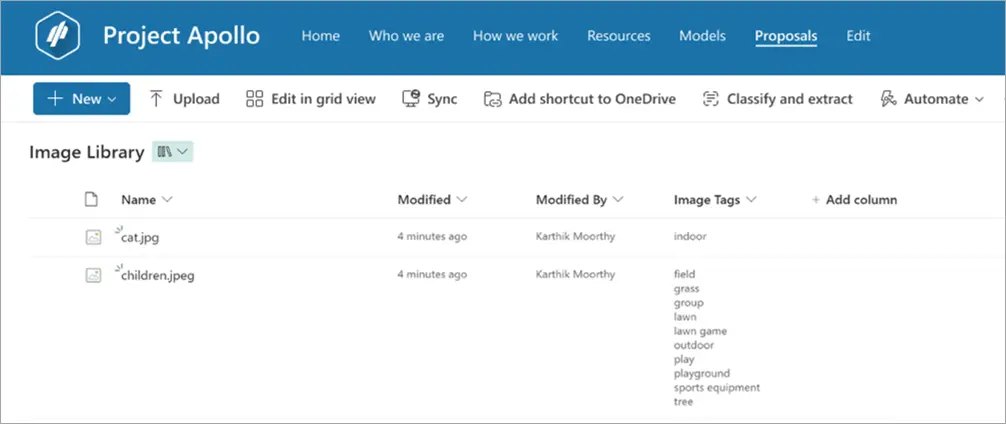In the ever-evolving landscape of enterprise technology, organizations continually seek solutions that streamline workflows, optimize productivity, and reduce operational costs. One such solution is Microsoft’s SharePoint Syntex, an innovative AI-powered document management system that harnesses artificial intelligence to automate content classification, extract key information, and enhance overall document processing. With businesses managing more data than ever before, SharePoint Syntex provides an intelligent way to work with content at scale.
This blog delves into what SharePoint Syntex is, its key features, and how it can transform your organization’s document management practices.
What is SharePoint Syntex?
SharePoint Syntex is a Microsoft 365 service built on the SharePoint platform, designed to bring AI to content management. It enables users to classify, organize, and extract important information from documents and content in an automated way. By using machine learning models, SharePoint Syntex helps companies manage vast amounts of data and unstructured content, offering intelligent insights and allowing better use of their information assets.

Key Features of SharePoint Syntex
- AI-Powered Content Understanding: SharePoint Syntex uses AI and machine learning to analyze documents, making it easy for users to identify and manage content based on specific rules. This feature helps to automate tasks like tagging, categorizing, and classifying documents based on the content within them, enabling efficient retrieval and management.
- Automated Metadata Tagging: One of the core challenges in document management is consistently tagging and categorizing content. SharePoint Syntex automatically extracts metadata from documents, helping users to locate information faster and ensuring consistent tagging across all content. This improves search accuracy and reduces manual effort.
- Content Classification Models: SharePoint Syntex allows organizations to build machine learning models that classify documents based on their types and content. For example, companies can create models to classify invoices, contracts, purchase orders, or legal documents, making it easier to organize and automate workflows around these documents.
- Enhanced Document Search: With AI-generated metadata and automated classification, searching for documents becomes more efficient. Syntex enhances the search experience by surfacing relevant information based on content rather than just file names or manual tags, resulting in quicker and more accurate results.
- Content Processing and Extraction: Not only does Syntex classify documents, but it can also extract specific data points from within the documents. This feature is especially useful for extracting key fields from forms, invoices, or contracts, such as due dates, amounts, or customer names, making it easier to populate other business systems or workflows.
- Seamless Integration with Microsoft 365: Since Syntex is built on SharePoint, it integrates seamlessly with other Microsoft 365 tools like Power Automate, Power Apps, and Microsoft Teams. This allows users to automate document workflows, trigger actions based on extracted content, and integrate document management into their daily tools and tasks.
Benefits of Using SharePoint Syntex for Document Management
- Increased Efficiency and Productivity: Automating document classification and data extraction significantly reduces the time employees spend on manual tasks. With Syntex, employees can focus on more critical business functions while letting AI handle the routine document management tasks.
- Improved Compliance and Governance: Ensuring documents are appropriately classified and tagged is crucial for regulatory compliance. Syntex helps maintain consistency in metadata and document classification, which supports compliance with industry regulations and internal governance policies.
- Cost Savings: By streamlining document management processes and reducing the need for manual data entry or classification, organizations can save on labor costs. Additionally, improved content management reduces storage costs by eliminating duplicate files and optimizing document retention policies.
- Scalability: Organizations can scale their document management strategies with ease using SharePoint Syntex. Whether handling thousands or millions of documents, the AI models in Syntex adapt and continue to learn, improving their accuracy and usefulness over time.
Use Cases for SharePoint Syntex
- Contract Management: In industries such as legal, procurement, and real estate, contract management is a critical process. SharePoint Syntex can automatically classify and organize contracts, extract essential information like dates, parties involved, and contract terms, and ensure compliance by tagging documents with the correct metadata.
- Accounts Payable Automation: For organizations dealing with hundreds or thousands of invoices each month, SharePoint Syntex can help by classifying invoices, extracting data like invoice numbers, due dates, and amounts, and streamlining approval workflows through Power Automate integration.
- Human Resources Documentation: Syntex can help HR departments organize and process large volumes of employee documentation, including resumes, performance reviews, and compliance forms. Automatically classifying and extracting data such as employee names, dates, and performance ratings saves time and ensures accurate record-keeping.
- Regulatory Compliance in Financial Services: Financial institutions are heavily regulated and must ensure that all documents are properly classified and retained. SharePoint Syntex can be trained to recognize compliance-related documents, apply retention labels, and automate workflows to ensure regulatory requirements are met without manual intervention.
Implementing SharePoint Syntex: Key Considerations
- Training AI Models: To fully leverage the power of Syntex, organizations need to invest time in training their AI models. This process involves teaching the model how to recognize and classify specific document types and extract key information. The more documents the AI processes, the better it becomes at accurately classifying and extracting data.
- Ensuring Data Security: As with any document management system, data security is crucial. SharePoint Syntex works within the secure framework of Microsoft 365, which means it benefits from Microsoft’s extensive security features like encryption, data loss prevention, and multi-factor authentication.
- User Adoption: While SharePoint Syntex offers many benefits, it’s essential to ensure that employees understand how to use it effectively. Training sessions and user guides can help your team learn how to work with Syntex, ensuring successful adoption.
Conclusion
SharePoint Syntex is revolutionizing the way organizations manage their documents by using AI to automate content classification and data extraction. With its ability to streamline workflows, enhance compliance, and reduce costs, Syntex is becoming a vital tool for businesses looking to improve efficiency and productivity in document management.
Whether it’s managing contracts, invoices, HR files, or compliance documents, Syntex delivers an intelligent, scalable, and highly secure solution that helps organizations optimize their information management processes.
FAQs
What types of documents can SharePoint Syntex process?
SharePoint Syntex can process a wide range of documents, including invoices, contracts, purchase orders, forms, and legal documents. It can be customized to handle industry-specific documents as well.
Is SharePoint Syntex difficult to implement?
While SharePoint Syntex requires training AI models to recognize and classify documents, Microsoft provides tools and resources to make implementation straightforward. Once models are trained, the system operates automatically.
Can SharePoint Syntex integrate with other Microsoft tools?
Yes, SharePoint Syntex integrates seamlessly with other Microsoft 365 tools, such as Power Automate, Power Apps, and Microsoft Teams, enabling users to build automated workflows around document processing.
Does SharePoint Syntex require a separate subscription?
Yes, SharePoint Syntex is an add-on service to Microsoft 365. Organizations need to purchase a separate license to access its AI-powered features.
How secure is SharePoint Syntex for document management?
SharePoint Syntex benefits from Microsoft’s robust security infrastructure, which includes features like data encryption, compliance tools, and access control. This ensures that your documents are securely managed within the Microsoft 365 ecosystem.

